
Serabi Kuah Kinca: Indonesian Coconut Milk Pancakes with Coconut Sauce
Servings: 30 -40 small pieces serabi
Calories: 98kcal
Indonesian coconut milk pancakes served with a rich coconut and palm sugar sauce. These serabi kuah kinca are tender, full of flavor, and perfect for dessert or a sweet afternoon snack.
Print Recipe
Ingredients
Saus kinca:
- 350 g coconut milk
- 100 g coconut sugar Indonesian palm sugar
- ¼ tsp salt
- 2 pieces jackfruit diced, I use canned jackfruit
- 1 tsp cornstarch dissolves with 1 Tbsp of water
Serabi batter:
- 150 g all-purpose flour
- 50 g rice flour
- ½ tsp instant yeast
- 40 g sugar
- 1 tsp baking powder
- ¼ tsp pandan essence
- 50 g egg
- 290 g canned coconut milk
To add last:
- ½ tsp salt
To cook serabi:
Instructions
Saus kinca:
- Place all ingredients for the sauce in the pan. Stir to mix everything and make sure there are no lumps. Cook it over low heat until the sugar is melted and turn the sauce into golden brown. Don't let the coconut milk boil over. Add jackfruit pieces or banana pieces if you choose to.
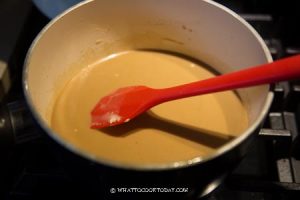
- Give the cornstarch slurry a stir and add into the sauce and continue to cook until the sauce thickens slightly and coats the spatula. If the sauce is too thick, you can always thin it out by adding a bit more water until you are happy with the consistency
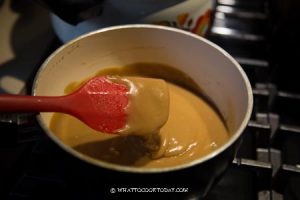
Make serabi batter:
- Whisk all-purpose flour, rice flour, sugar, yeast, baking powder in a mixing bowl.
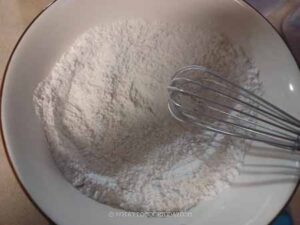
- Add egg, coconut milk, pandan essence (if using) and whisk until the batter is smooth with no lumps
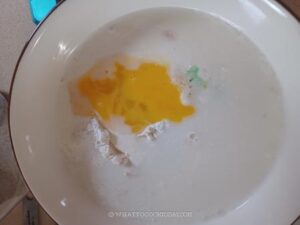
- Strain the batter with a mesh strainer if necessary
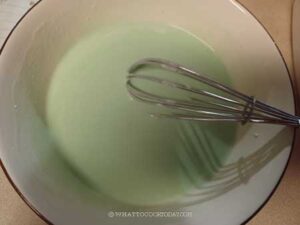
- Cover and rest the batter in a warm place (I use my oven's bread proof function) to let it proof until you see bubbles on the surface. This may take about one hour, depending on the temperature. The batter should look puffy and rise a bit with some air bubbles here and there

- You can see fermentation is going on here
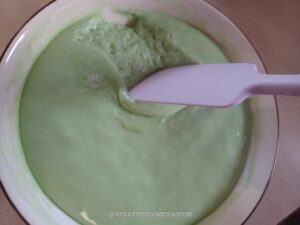
- Add the salt and whisk again to combine until the batter is smooth again
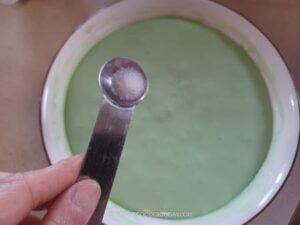
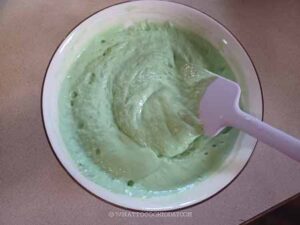
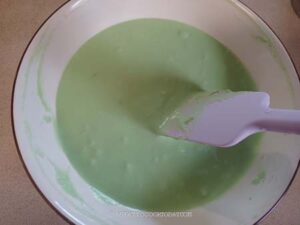
Cooking serabi:
- Preheat a non-stick pan over medium-low heat for 2-3 ,minutes. Make sure the pan is hot but not overly hot. Wipe the pan with a paper towel soak with a bit of oil.
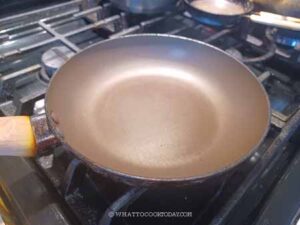
- The heat level is between medium and low for my stove
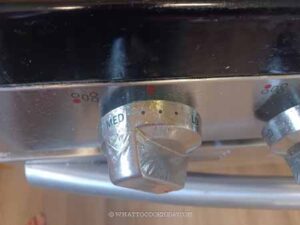
- Important tips: when the batter first hits the pan you should be able to hear a bit of sizzling.
- I recommend cooking one pancake at a time for at least the first 2-3 pancakes to help you estimate how much heat you need and let you figure things out. The first few serabi won't be the best one usually (or they might be too).
- Ladle about 1/8 cup of the batter onto the pan and use the back of the ladle or whatever you use to scoop the batter to lightly smear the batter into a circle and a bit thinner. I notice if the batter is too thick, less bubbles on the surface of the serabi

- You will start seeing small and large bubbles appearing and popping/breaking on the surface of the pancake.
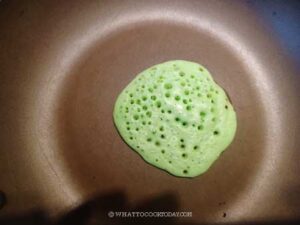
- When you start seeing quite a few of that, lower the heat by one to two notches (this depends on your stove too). I lower mine by one notch
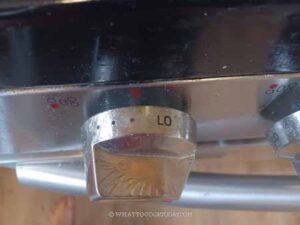
- Then when no more bubbles appear, you can lower the heat all the way down and cover with a lid to let the wet spots on the surface to dry up. This only takes about 5-10 seconds
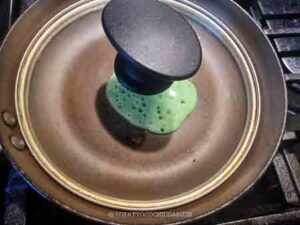
- Uncover the lid and you shouldn't see any more wet spots on the surface and the bottom should be golden brown. If it's too dark, you can adjust the level of heat for the next round. Transfer to a plate.
- If you want to make the folded pancake, simply fold it over when it's still warm
- Important tips: Remember to stir the batter everytime before you use it. Make sure the pan remains hot and increase the heat back to medium-low again before you start cooking the next batch. I recommend cooking 3-4 at a time (depending on the size of your pan)
Serving:
- Serve the serabi with the saus kinca on the side
Storing leftovers:
- Serabi and the kuah can be stored in the refrigerator for up to one week. Simply reheat the serabi by steaming on medium heat for 2-3 minutes or in the microwave on high for 10-15 seconds or until just warm. The kuah can be reheated in the microwave for 15-20 seconds and then stir and see if you need to loosen up the sauce if it gets too thick. You can add a bit of water to get the consistency you like.
Nutrition
Serving: 1serving with sauce | Calories: 98kcal | Carbohydrates: 13g | Protein: 2g | Fat: 5g | Saturated Fat: 4g | Polyunsaturated Fat: 0.1g | Monounsaturated Fat: 0.3g | Trans Fat: 0.001g | Cholesterol: 6mg | Sodium: 86mg | Potassium: 107mg | Fiber: 1g | Sugar: 6g | Vitamin A: 20IU | Vitamin C: 2mg | Calcium: 16mg | Iron: 1mg